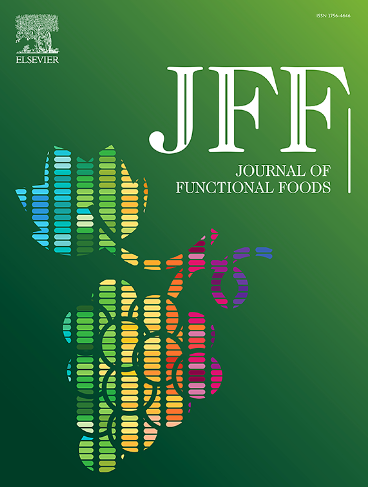创新的肉毒碱喂养大鼠模型揭示了白藜芦醇丁酸酯在降低氧化三甲胺和心血管风险中的多机制作用
IF 4
2区 农林科学
Q2 FOOD SCIENCE & TECHNOLOGY
引用次数: 0
摘要
三甲胺- n -氧化物(TMAO)是一种肠道微生物来源的膳食肉碱代谢物,是心血管疾病(CVD)的危险因素。高脂肪和肉毒碱丰富的饮食增加TMAO水平,使其适合模拟饮食诱导的心血管疾病。白藜芦醇丁酸酯(RBE)及其单体3- o -丁醇白藜芦醇(ED4)已显示出降低氧化三甲胺水平和改善心血管结局的潜力,但其机制尚不清楚。本研究建立了一种新的大鼠模型,通过高脂肪和富含肉毒碱的饮食来提高血清TMAO水平,模拟饮食诱导的CVD风险,并研究了ED4的治疗作用。分析生理、生化、微生物和基因表达谱。ED4补充剂通过上调有机阳离子转运体新家族成员2 (OCTN2)表达、促进尿TMAO排泄和恢复短链脂肪酸(SCFA)水平来降低血清TMAO水平。ED4还可以调节肠道微生物群,减少产生tma的细菌,改善心血管指标,包括降低血脂水平和脂肪积累。二甲基丁醇通过抑制含黄素单加氧酶3 (FMO3)表达来降低氧化三甲胺,而ED4主要通过肉碱利用和微生物群调节发挥作用。两种治疗方法都提高了尿TMAO排泄,改变了肠道菌群组成。本研究提出了一种创新的动物模型,结合高脂肪和肉毒碱的饮食来研究tmao相关的心血管风险。ED4通过调节肠道菌群、恢复SCFA水平和增强肉毒碱代谢,在降低TMAO水平和心血管疾病危险因素方面具有多机制作用。这些发现突出了ED4在心血管保护和代谢调节方面的治疗潜力。然而,需要进一步的研究来阐明ED4对氧化三甲胺代谢影响的分子途径及其更广泛的翻译应用。本文章由计算机程序翻译,如有差异,请以英文原文为准。

Innovative carnitine-fed rats model reveals resveratrol butyrate Ester's multimechanistic role in reducing TMAO and cardiovascular risk
Trimethylamine-N-oxide (TMAO), a gut microbiota-derived metabolite from dietary carnitine, is a risk factor for cardiovascular disease (CVD). High-fat and carnitine-enriched diets increase TMAO levels, making them suitable for modeling diet-induced CVD. Resveratrol butyrate ester (RBE) and its monomer 3-O-butanoylresveratrol (ED4) have shown potential in reducing TMAO levels and improving cardiovascular outcomes, but their mechanisms remain unclear. This study established a novel rat model with high-fat and carnitine-enriched diets to elevate serum TMAO levels, simulating diet-induced CVD risks, and investigated the therapeutic effects of ED4. Physiological, biochemical, microbial, and gene expression profiles were analyzed. ED4 supplementation reduced serum TMAO levels by upregulating organic cation transporter novel family member 2 (OCTN2) expression, promoting urinary TMAO excretion, and restoring short-chain fatty acid (SCFA) levels. ED4 also modulated gut microbiota, reducing TMA-producing bacteria, and improved cardiovascular markers, including lowered blood lipid levels and fat accumulation. While dimethylbutanol inhibited flavin-containing monooxygenase 3 (FMO3) expression to reduce TMAO, ED4 acted primarily through carnitine utilization and microbiota modulation. Both treatments enhanced urinary TMAO excretion and altered gut microbiota composition. This study introduced an innovative animal model combining high-fat and carnitine-enriched diets to study TMAO-related cardiovascular risks. ED4 demonstrated multi-mechanistic effects in reducing TMAO levels and CVD risk factors by modulating gut microbiota, restoring SCFA levels, and enhancing carnitine metabolism. These findings highlight ED4's therapeutic potential in cardiovascular protection and metabolic regulation. However, further research is needed to elucidate the molecular pathways underlying ED4's effects on TMAO metabolism and its broader translational applications.
求助全文
通过发布文献求助,成功后即可免费获取论文全文。
去求助
来源期刊

Journal of Functional Foods
FOOD SCIENCE & TECHNOLOGY-
CiteScore
9.60
自引率
1.80%
发文量
428
审稿时长
76 days
期刊介绍:
Journal of Functional Foods continues with the same aims and scope, editorial team, submission system and rigorous peer review. We give authors the possibility to publish their top-quality papers in a well-established leading journal in the food and nutrition fields. The Journal will keep its rigorous criteria to screen high impact research addressing relevant scientific topics and performed by sound methodologies.
The Journal of Functional Foods aims to bring together the results of fundamental and applied research into healthy foods and biologically active food ingredients.
The Journal is centered in the specific area at the boundaries among food technology, nutrition and health welcoming papers having a good interdisciplinary approach. The Journal will cover the fields of plant bioactives; dietary fibre, probiotics; functional lipids; bioactive peptides; vitamins, minerals and botanicals and other dietary supplements. Nutritional and technological aspects related to the development of functional foods and beverages are of core interest to the journal. Experimental works dealing with food digestion, bioavailability of food bioactives and on the mechanisms by which foods and their components are able to modulate physiological parameters connected with disease prevention are of particular interest as well as those dealing with personalized nutrition and nutritional needs in pathological subjects.
 求助内容:
求助内容: 应助结果提醒方式:
应助结果提醒方式:


